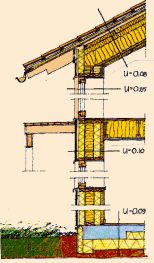| Passive Houses in Cold and in Mediterranian Climates The first Passive House has been built in a cold-temperate Central European climate where the energy demand for heating has been predominant. Therefore, excellent thermal insulation, highly insulated windows and heat recovery from exhaust air have been the key technologies. In the meantime, first Passive Houses have also been built in Northern and Eastern Europe. In particular improved thermal insulation, excellent airtightness and an efficient ventilation system have proved its worth there as well.
Passive Houses in Gothenburg, architect Hans Eek / a project within CEPHEUS Cold climates demand still higher standards of Passive House elements. In order to keep the heating load low, insulation needs to be further improved. Demands on window technology are also rising. On the other side Passive Houses are spreadimg across the Alps towards Southern Europe numerous projects have already been successfully built in Southern Tyrol. The more the climate is different from central European conditions, the more building services and elements of Passive Houses need to adapt to the changed circumstances. The Passive House is a functional and integral concept, where not fixed U-values of windows and building elements are required but thermal comfort in summer and in winter times with little energy consumption. Naturally, in the Mediterranean region summer cooling is more in the foreground. Passive-On, a project of the European Union, is explicitly concerned with the application of Passive House principles in Southern Europe. It is also helping to carry out the 10th conference on Passive Houses. First results of the project Passive-On will be presented in two presentations at this conference in Hanover in May 2006. This is subject of Next to an exchange of gained experiences, in this working group
new and specific questions may also be tackled, e.g.: The frequency
of condensate occurance and the freezing of exterior surfaces may
increase, just like the freezing of heat exchangers for indoor ventilation.
Working
group No. VIII is part of the international sessions. Only papers
in english are accepted for this working group. Time
schedule of the 10th International Conference on Passive Houses
in Hannover The PHI is
not responsible for the content of linked web-pages. |
| Download | |
| > | 2005-08-14 Folder of the 10th International Conference on Passive Houses (fanfold)  PDF 248 kb PDF 248 kb |
| > | 2005-08-14 Abstract form (10PH Conference Abstract) DOC 10 kb |

